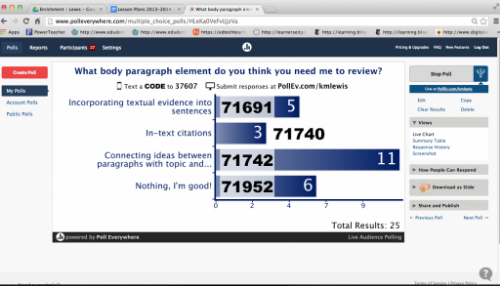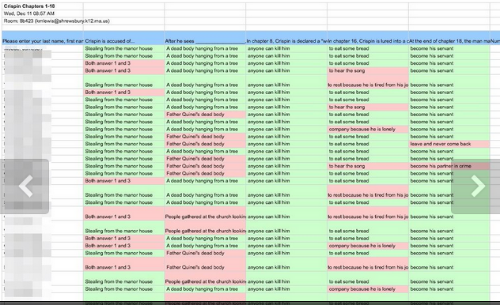3 Ways To Use Data In The Classroom
By Kate Lewis
The phrase “using data to drive instruction” is showing up everywhere in education circles lately. Particularly with the incorporation of the Common Core State Standards, and new standardized tests and teacher evaluation systems, the way that teachers use data is becoming more and more important. But what exactly does it look like in the classroom? And how can technology help make the process more manageable?
Using data in the classroom doesn’t have to be as intimidating as it sounds. My favorite way to use data in my eighth grade English Language Arts classroom is to use formative assessment data to drive instruction and for intervention. Here are three easy ways to start using data in the classroom:
Take a Poll
Online polling systems are an excellent resource for teachers. Recently, I used Poll Everywhere to ask my students what topic they would like to review. I certainly could have just listed the topics out loud and asked students to raise their hands. However, in my experience, the information a teacher gets using that method is not reliable. In general, students are much more open and honest when using technology than they would be in almost any other situation. When I take polls the old fashioned way with students raising their hands to indicate their preference, I can see them furtively looking around to see what their friends are doing. Particularly in middle school, students don’t want to stand out or be different. They may be less likely to be honest when they are raising their hands in front of everyone. But taking an anonymous poll on an iPad or another device takes that worry away, providing the teacher with reliable data. This was the result that came from the poll when I asked students what they needed more help with:
Clearly, my students wanted to review using topic and concluding sentences to connect ideas. I don’t think there would have been 11 hands up if I asked students to raise their hands. Most likely, they would have said they don’t need help with anything to avoid looking “stupid.” I was able to use this data to inform my lesson for the day. One of the great features about polling systems like Poll Everywhere is that they are so quick to use that teachers can create polls on the fly to address student needs. Based on this data, I quickly designed two poll questions and used them to review the concept during that very same class period. Here is an example of what that looked like:
I was able to project student responses and use them to help students see what effective topic and concluding sentences look like. Then, students spent the rest of the class using that knowledge to write their own body paragraphs. The data allowed me, as a teacher, to effectively respond to student needs.
Use a Quick Quiz to Drive Instruction
There are many digital tools that make quick formative assessments much easier and more effective. One of my favorite tools to use is Socrative. I frequently use Socrative for quick reading check-in quizzes at the beginning of class. There are several reasons why using digital tools for quick formative assessments is better than having the students take quizzes using paper and pencil. First of all, the teacher can set up the quiz to tell the students if they got an answer correct or incorrect, so the students are getting instant feedback rather than waiting for the teacher to correct the quiz and hand it back, possibly waiting until the next day or even longer. We all know that quick feedback is effective feedback, and technology can facilitate that process. Secondly, as soon as the students complete the quiz, the program sends a report to the teacher. This is the report from the last formative assessment I gave in my classroom:
Not only does the report save time because the teacher doesn’t have to correct and gather the data, it also allows the teacher to instantly respond to student needs. From this assessment data, I was able to tell that many students were struggling to understand how a key plot event impacted the development of a character in the novel they are reading. This led to an improvised lesson on indirect characterization. I was able to use the data instantly to inform my lesson to address comprehension issues, whereas before, I wouldn’t have even known it was an issue until much later. At that point, the lesson would not have been as effective.
Use Formative Assessment Data for Immediate Intervention
After using Socrative for quick formative assessments, I quickly discovered that I could use the data in more than one way. Not only could I use it to inform whole class instruction, but I could also use it to target individual students for intervention. There were instances where a student got incorrect answers on four or five questions out of five. Because I had the report in my hands right away and the students were sitting in my classroom, I was able to sit down with struggling students to create intervention plans. Using the data, I could see particularly what areas were causing a problem for the student. If a student was struggling with vocabulary in context, I was able to provide additional resources they could use as they read independently. If a student was struggling to remember important details from the text, I was able to recommend an alternate strategy for annotating as they read. Finally, if I saw that a student was simply falling behind with their work, I could sit with them and create a plan to help them get caught up. These interventions didn’t take long, just a few minutes with each student during class, but I could see immediate results. Using data for intervention prevented problems from snowballing out of control, and made a big difference with the students who were struggling.
Overall, there is not one “right” way to use data in the classroom. Using technology makes the process quicker and more effective, and allows teachers to adjust their instruction to meet student needs or provide interventions. Since I starting focusing on using data in the classroom, I have seen the positive impact it can have student learning. Clearly, there are many other ways to use data, but formative assessment is a good place to start.




No comments:
Post a Comment